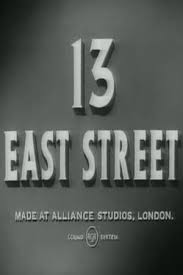
13 EAST STREET
UK, 1952, 72 minutes, Black and white.
Patrick Holt, Sandra Dorne, Sonia Holm, Robert Ayres, Dora Bryan, Michael Balfour, Michael Brennan.
Directed by Robert S. Baker.
This is a small supporting feature with a familiar enough plotline. However, the audience is not informed about the police inspector going underground until about 20 minutes into the film.
The film opens with a Scotland Yard inspector the dressing a group of colleagues and telling the story of Gerald Blake (Patrick Holt Is a stalwart kind of hero). The film then shows him in a bank robbery, his being pursued by the police, eventually arrested. In custody, he attracts the attention of a small-time thug, Joey, Michael Balfour, and finally shares a cell with him. Gerald is very straight up-and-down but, when they are transferred from one prison to another, Joey feigns of coughing fit and they escape from the train. Joey leads him to his boss, Larry (Robert Ayres) and despite the misgivings of Mack, Michael Brennan, who had met Gerald before, when being arrested, but could not remember who he was.
The film shows Gerald being incorporating into the gang, involved in robberies and black-market sales. Larry’s girlfriend, Judy (Sandra Dorne, later married to Patrick Holt) does a line for Gerald.
Gerald also keeps in contact with a fellow officer who ultimately, is gunned down. He also is able to keep in touch with his long-patient wife (Sonia Holm, married to Patrick Holt at this time).
There are several tangles providing some excitement, Gerald being called on to assist in the final robbery at a wharf, illegal furs. He is able to get through some kind of communication with headquarters who then turn up for surveillance. The final climax is a chase through the wharf and warehouse, Mack wearing a coat that Larry had given to Gerald with Mack being jealous of it, with the result that Larry shoots Mack thinking it is Gerald.
Mission accomplished. Very tidy, very British – and a reference to a charge of the king versus… Which means that it was made at the end of King George VI’s reign and released when Queen Elizabeth had begun her reign in 1952.